This is part of a series of monthly posts reflecting different thought leader perspectives on utility rate design. All five opinion pieces appear in full in Leadership in Rate Design: A Compendium of Essays, which was designed to help public power utilities to rethink rate design strategies in the face of evolving technologies and customer preferences. The essays were developed as part of the Association's Moving Public Power Forward initiative.
The Regulatory Assistance Project sets out three guiding principles for smart rate design in its handbook for rate analysts and utility oversight bodies:
- Customers should be able to connect to the grid for no more than the cost of connecting to the grid.
- Customers should pay for grid services and power supply costs based on how much power they use and when they use it.
- Customers supplying power or grid services to the utility should receive full and fair compensation, no more and no less.
What do these principles mean in practice?
Customer-specific costs only
The first principle of smart rate design tells us that customers should be able to connect to the grid for no more than the customer-specific costs of connection — up to, but not including, any components of the system that serve multiple customers. This usually includes the service drop to their home or business, plus the costs of metering and billing. On typical urban/suburban power systems, shared distribution system components such as poles, conductors, and transformers generally should not be included in the monthly fixed charge, as these costs will not change if the number of customers changes unless their combined usage changes.
The resulting analysis generally produces a per month cost of about $5 for typical municipal utilities billing water, sewer, and other services on a single bill. It can run up to $10 per month for utilities billing for a single service, because the costs of billing and collection are not spread across multiple services. A cost study that produces customer costs above this level likely includes shared distribution costs.
Volume and time of use
The second principle of smart rate design tells us that rates should recover costs based on the volume of usage, differentiated by season, usage level, and time of use (where advanced metering is in place). Seasonal rates and time-of-use rates directly concentrate cost recovery on users during high-cost periods.
Inclining block rates approximate the effect of TOU rates, because high-use customers tend to be electric heating and cooling users, and these end-uses are concentrated in the high-cost periods for most utilities.[i] Inclining block rates are a good second-best solution where advanced metering is not in place. In addition, many utilities use inclining block rates to allocate a limited low-cost resource, such as hydro, equitably to all customers.
Full and fair compensation
The third principle of smart rate design recognizes that many customers are providing power and other grid services back to utilities. This began with solar photovoltaic systems and demand response providing surplus energy and peak load reduction. Today’s customers — with smart inverters, smart electric vehicle chargers, and customer-side batteries — may provide a wider range of ancillary services, such as voltage support and frequency regulation. These system benefits are increasingly recognized by value-based compensation frameworks.[ii]
From Principles to Practice
Several public power utilities have implemented rates consistent with the three smart rate design principles and in a manner appropriate to local circumstances.
Inclining block rates
An inclining block rate is a simple rate that does not require advanced metering. A higher rate is imposed on higher levels of usage, recognizing a well-understood (but not perfect) relationship between high levels of usage and high levels of peak orientation of loads, and between low levels of usage and closely-spaced dwelling units (apartments and multiplex units). It is quite simple to construct an inclining block rate from a typical commercial demand charge rate, using the different load factors of different end-uses in the residential sector and the blocks in which these end-uses are dominant:

Many utilities use inclining block rates — in fact, this is the most common residential rate form globally, and is nearly universal in India, Indonesia, China, and Mexico.
Seattle City Light is a hydropower-rich utility, with a winter-peaking residential load. Power costs in the Western interconnection are highest in summer, and the utility is nearly always a buyer or seller in this market. Its rate design reflects the limited hydro and seasonal cost structure. Seattle also has a slightly higher rate that applies to service outside the city limits, reflecting the higher cost of service in suburban areas. The inclining block rate in Seattle primarily benefits apartments, and the separate, higher suburban rate benefits urban consumers.City of Palo Alto, California bills multiple utility services (electric, natural gas, water, sewer) together and its customer billing costs are low for each service. It has elected to have no fixed monthly charge for electricity.
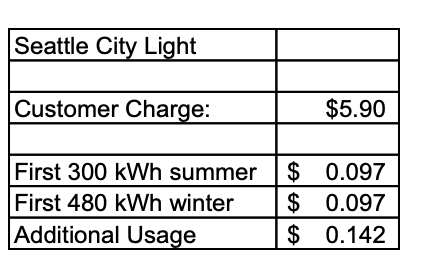
City of Palo Alto, California bills multiple utility services (electric, natural gas, water, sewer) together and its customer billing costs are low for each service. It has elected to have no fixed monthly charge for electricity.
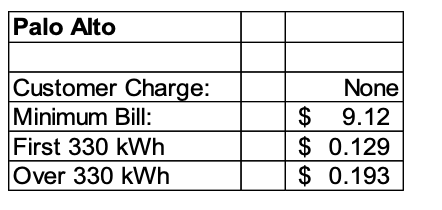
Burlington Electric Department in Vermont has a historical allocation of low-cost hydropower from projects built a century ago and gets much of the rest of its power in the relatively expensive New England ISO market. The rate design recognizes a per-customer allocation of the low cost hydropower.

Rates that vary by customer connection size
Half of Burbank Water and Power’s customers live in multi-family dwelling units, which are less expensive to serve than its customers who live in large, single-family homes with central air conditioning, swimming pools, and other high-usage electric appliances. Burbank divided its rate into a customer charge for billing, collection, and customer service costs; a “service size charge” for location-specific distribution capacity (final line transformers and the secondary service lines); and an energy charge for all distribution network and power supply costs. The service size charge is tied to the customer electrical panel capacity recorded in the city’s building records. The result is a rate that recognizes the lower cost of service for smaller customers and the higher cost of service for larger users. The 100-amp service panel is common for apartments; most single-family homes have 200-amp panels, and large homes sometimes have 400-amp panels. The utility also retains an inclining block rate form reflecting California’s long-standing commitment to encouraging energy efficiency.
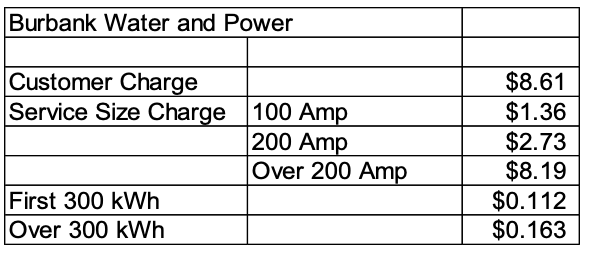
Rates for compensating solar customers
Many utilities offer customers with solar photovoltaic systems simple net metering, an approach that works well up to about 5% penetration, as the impacts on other customers are very small. Once solar becomes common, a more cost-based solution might be appropriate.
Austin Energy in Texas uses a value of solar approach that carefully evaluates all components of the benefits to the society that solar produces, not just the short-term benefits to the utility. These benefits include generation, transmission, and distribution capacity; energy costs; and appropriate environmental and social values. A rolling five-year average is used to smooth volatile values.
Austin has an inclining block residential rate. Without the VOS approach, solar customers would not see the benefit of the low-cost initial blocks of power, as their solar system might entirely displace these purchases. Instead, Austin has a fixed price that it pays for all solar generation, and then it supplies all power used by the customer under the inclining block rate. The rate below shows the effect, after including various rate adders:
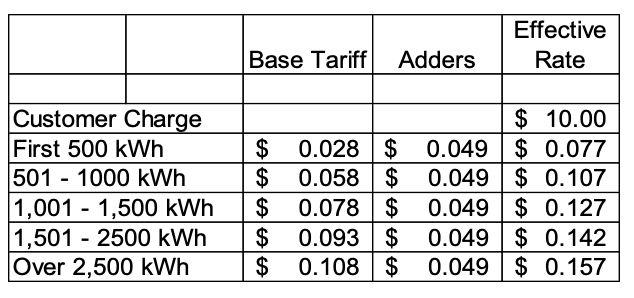
Solar customers receive a VOS credit of $0.097 per kWh for all output from their PV systems, of which less than one-third represents the variable energy cost avoided by the utility. For customers with usage under 500 kWh/month, the solar credit more than offsets the utility per-kWh rate, but for larger users, the solar credit is only a portion of the rate they pay for incremental usage.
Time of Use Rates
Fort Collins Utilities in Colorado recently deployed universal time of use rates for residential customers. A “tier charge” on all usage over 700 kWh/month retains the effect of an inclining block rate within the framework of a TOU rate (electric heat customers pay a slightly higher base rate and are exempt from the tier charge). The fairly short periods in which the on-peak rates apply — five hours per day in summer and four hours per day in the non-summer months — means customers can more easily shift loads such as laundry and water heating into the low-cost hours. The off-peak rate provides electric vehicle charging at the equivalent of less than a dollar per gallon of gasoline.
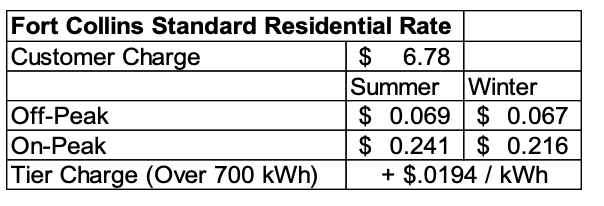
Rates directed at EV charging
Burbank customers with EVs have access to a rate that provides an attractive charging price. The customer pays this rate for all usage but must have an EV to qualify for the rate. The key characteristic is the off-peak rate that is about half of the standard rate. Unlike standard rate customers, EV rate customers are not subject to the higher second-tier rate for usage over 300 kWh/month (an EV typically uses 200–300 kWh/month by itself). The standard inclining block rate, without a TOU element, would be a potential barrier to EV deployment.
Customers with Burbank’s EV TOU rate have the same fixed charge as other residential customers and the same service-size charge. Only the per-kWh rate is different.
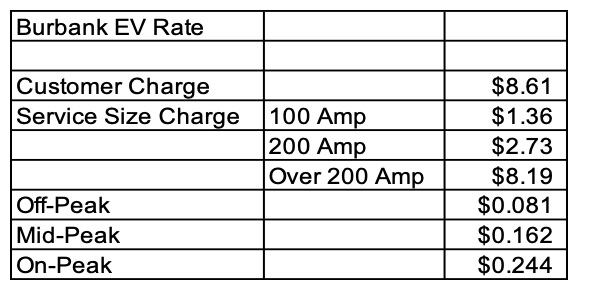
At $0.08/kWh, Burbank’s off-peak EV rate is equivalent to about a dollar per gallon of gasoline.
Rates for small commercial customers
Small non-residential customers generally are served with rates that do not include demand charges. A demand charge for this class of customers would unfairly shift costs to customers with intermittent usage who can share system capacity with other customers with complementary usage patterns. A TOU energy charge is more equitable, ensuring that customers with continuous usage in high-cost periods pay a larger share of system capacity costs.
Burbank is an example of a smart rate for small commercial customers that is easy to understand. It incorporates most system capacity costs into the on-peak and mid-peak rates. The 2:1 ratio between on-peak and off-peak prices provides these customers a strong incentive to install ice-storage air conditioning or other load-shifting technology. The short three-hour on-peak period provides customers a reasonable opportunity to curtail load that can be deferred.
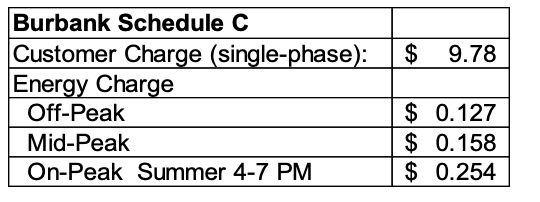
Rates for large commercial customers
Large commercial customers have been served with three-part rates for decades, with separately stated demand charges that have generally applied to the customer’s highest demand whenever it occurs. Today, with wind, solar, storage and other options available to both the utility and the customer, traditional non-coincident demand rates make little sense. Neither generation nor network distribution capacity is planned or built based on non-coincident peak demand. Typically, these large customers have dedicated transformers sized to their individual demand — but nothing upstream of the final line transformer is.
A high demand charge provides commercial customers an incentive to curtail usage or add batteries to shave demand charges in the customers’ highest-use hours. But the customers’ highest-usage hours may not occur during the same hours that are most important for the grid.
Sacramento Municipal Utility District has taken a significant step toward making rates for large commercial customers that reflect today’s cost realities. SMUD offers these customers a clear set of signals on how to modify their loads to minimize their bills and help minimize system costs.
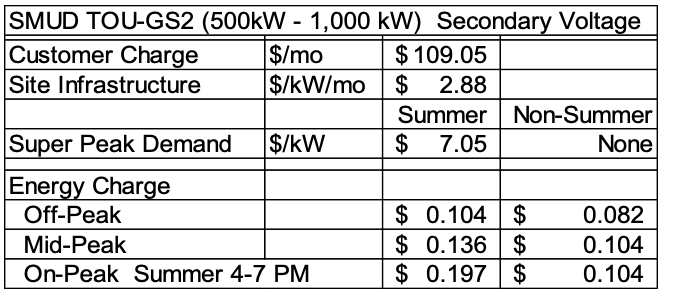
This rate imposes a “site infrastructure” demand charge, based on the highest annual usage, to fully recover the site-specific distribution capacity cost. But this charge is less than $3 per kW per month, far lower than most utility demand charges, reflecting only local customer-specific infrastructure costs. And it has a summer super-on-peak charge to recover the cost of additional peaking capacity. But all other costs are properly built into the volumetric TOU energy charges.
Keeping Rates Competitive
The most important lesson is that one common rate design approach used by some utilities to reflect “fixed” distribution costs in fixed charges is NOT a part of smart rate design. Most business enterprises exist to invest capital and employ labor and other resources to produce products and services that their customers purchase on a volumetric basis. Whether this is farmers growing broccoli, oil refineries producing gasoline, or supermarkets selling a wide variety of products, the principle is the same — fixed and variable costs are recovered in the unit prices for the products sold. Competitive businesses do not charge their customers a fixed fee to cover any portion of their infrastructure costs. If they did so, they would risk losing their smaller-usage customers to competitors.
In the electric industry, very small-use electric customers are leaving the utility grid to avoid electric utility fixed charges. As an example, solar powered pedestrian crossing signals. These signals are usually adjacent to the grid serving schools, so there would be no additional distribution system expansion needed to serve them, but often, utility rate design — imposing a fixed charge of $10–$20 per month — makes it uneconomical to connect to the grid.
Today, these off-grid solar systems are economical for loads of a few kWh per month. With declining costs for solar and storage, they might soon be attractive for customers using a few hundred kWh per month. Utilities risk alienating and losing millions of customers, and the associated revenue, if they attempt to assign significant portions of distribution system cost on a per-customer basis.
One of the primary purposes for establishing utility regulation, including the statutory obligation of governing boards of consumer-owned utilities in most states, is to prevent the exercise of monopoly power in pricing. Utility prices should generally not vary from the kinds of pricing that would emerge under competition in competitive industries. The smart rate design principles meet this standard.
As the U.S. Supreme Court ruled in the landmark Market Street Railway case, “Even monopolies must sell their services in a market where there is competition for the consumer’s dollar and the price of a commodity affects its demand and use.”[i] Smart utilities employing smart rate design principles will not run afoul of this guidance.
[i] Market St. Ry. Co. vs Railroad Commission of State of California, 324 US 58, 1945.
[i] See Faruqui, A., “Inclining Towards Efficiency,” Public Utilities Fortnightly, August 2008.
[ii] For a more detailed discussion of this opportunity and options for fair compensation, see Hledik, R. and Lazar, J., Distribution System Pricing With Distributed Energy Resources, Lawrence Berkeley National Laboratory, 2016, and Linvill, Shenot, and Lazar, Designing Distributed Generation Tariffs Well, Regulatory Assistance Project, 2013.
